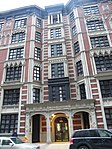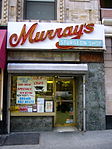Soldiers' and Sailors' Monument (Manhattan)
1902 establishments in New York CityBuildings and structures completed in 1902New York City Designated Landmarks in ManhattanRiverside Park (Manhattan)Union (American Civil War) monuments and memorials in New York (state) ... and 2 more
Upper West SideUse mdy dates from August 2019

The Soldiers' and Sailors' Memorial Monument is a monument located at 89th Street and Riverside Drive in Riverside Park in the Upper West Side of Manhattan, New York City. It commemorates Union Army soldiers and sailors who served in the American Civil War. It is an enlarged version of the Choragic Monument of Lysicrates in Athens, and was designed by the firm of Stoughton & Stoughton with Paul E. M. DuBoy. The monument was completed in 1902.
Excerpt from the Wikipedia article Soldiers' and Sailors' Monument (Manhattan) (License: CC BY-SA 3.0, Authors, Images).Soldiers' and Sailors' Monument (Manhattan)
Riverside Drive, New York Manhattan
Geographical coordinates (GPS) Address External links Nearby Places Show on map
Geographical coordinates (GPS)
| Latitude | Longitude |
|---|---|
| N 40.792222222222 ° | E -73.978888888889 ° |
Address
Soldiers' and Sailors' Monument (Sailors' and Soldiers' Monument)
Riverside Drive
10024 New York, Manhattan
New York, United States
Open on Google Maps











